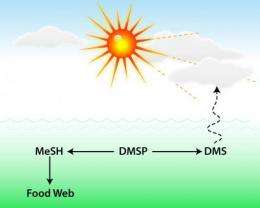Scientists discover missing links in the biology of cloud formation over the oceans

Scientists have known for two decades that sulfur compounds that are produced by bacterioplankton as they consume decaying algae in the ocean cycle through two paths. In one, a sulfur compound dimethylsulfide, or DMS, goes into the atmosphere, where it leads to water droplet formation – the basis of clouds that cool the Earth. In the other, a sulfur compound goes into the ocean's food web, where it is eaten and returned to seawater.
What they haven't known is how sulfur is routed one way or the other or why.
They also have wondered what if – in a time of growing concern about global warming – it was possible to divert the sulfur compound that goes into the oceans into the atmosphere, helping to mitigate global warming?
A study by researchers at the University of Georgia just published in Nature brings the possibility of using the sulfur cycle to mitigate global warming closer with the identification of the steps in the biochemical pathway that controls how bacteria release the sulfur compound methanethiol, or MeSH, into the microbial food web in the oceans and the genes responsible for that process.
"With our increased understanding of the sulfur cycle in the ocean," said study co-author William (Barny) Whitman, "we are now better able to evaluate the impacts of climate change on the process and the potential for its manipulation, which has been proposed as a way to mitigate global warming.
"It's wonderful to have this much understanding of a major biogeochemical process," noted Whitman, distinguished research professor and head of the department of microbiology in the Franklin College of Arts and Sciences.
In addition to elucidating the steps in the pathway and identifying the responsible genes, the team of UGA microbiologists, marine scientists and chemists discovered that the pathway is found widely, not only among bacterioplankton in the ocean but also in non-marine environments.
"The big mystery about bacteria is what they are doing in nature," Whitman said. "The organisms metabolize compounds for their own needs. We need to understand what they are getting out of it to understand what it means for the ocean, and now it will be possible to look at the environmental importance of this process and how it's regulated." That will help to answer the "why" of the two sulfur fates.
Co-authors of the Nature paper were UGA graduate students Chris Reisch and Vanessa Varaljay, department of microbiology; graduate student Melissa Stoudemayer and Jon Amster, professor and head, department of chemistry; and distinguished research professor Mary Ann Moran, department of marine sciences – all in the Franklin College of Arts and Sciences.
The collaborators in this study built on a line of research begun at UGA over a decade ago. Moran's early research showed that an abundant group of bacteria known as marine roseobacters play a role in moving dimethylsulfonioproprionate (DMSP), the chemical made by marine algae and released into the water upon their death, into the atmosphere as the compound dimethylsulfide (DMS).
In 2006, Moran's research group discovered in marine bacteria the first step in the process of turning DMSP into MeSH, instead of sending sulfur into the atmosphere. And in 2008, Moran's doctoral student Erinn Howard, in collaboration with Whitman's lab, discovered the gene that allows marine roseobacters to keep sulfur in the ocean.

With funding from the National Science Foundation and the Gordon and Betty Moore Foundation, the UGA researchers have now identified the rest of the pathway, including identifying two previously unknown but related chemical compounds that serve as intermediates between MMPA, the first product of degraded DMSP, and MeSH, the final product.
The collaboration with UGA chemists using high-resolution mass spectrometry made it possible for the researchers to identify the compounds. A major surprise was the presence of Coenzyme A (CoA), a large molecule important in metabolism, in the intermediate compounds.
"We weren't really expecting CoA to be involved," said Reisch, who was part of the UGA group that five years ago identified the first step in the pathway that produces MeSH. "We thought they would be smaller fatty acids."
With the discovery of the intermediates, it was possible to find the enzymes that catalyzed the reaction and then the genes. And once the genes were discovered, the researchers were able to analyze databases of marine bacteria to determine which bacteria possess the genes capable of carrying out the MeSH process.
The group discovered that the MeSH pathway is widespread among bacterioplankton in the ocean. "The genes may be in up to 61 percent of surface ocean bacterioplankton," said Reisch, "while the DMS pathway is present in less than 5 percent of cells." However, he said, "There could be a lot more that we don't yet know about. Some bacteria, including the model bacteria used in the study, have both pathways."
But the researchers also found the genes for the MeSH pathway in bacteria from a variety of non-marine habitats, including bacteria commonly found in soils, plants, extreme environments and humans. They note in their Nature paper that the presence of the newly discovered pathway in diverse bacteria further emphasizes its importance.
Provided by University of Georgia

















